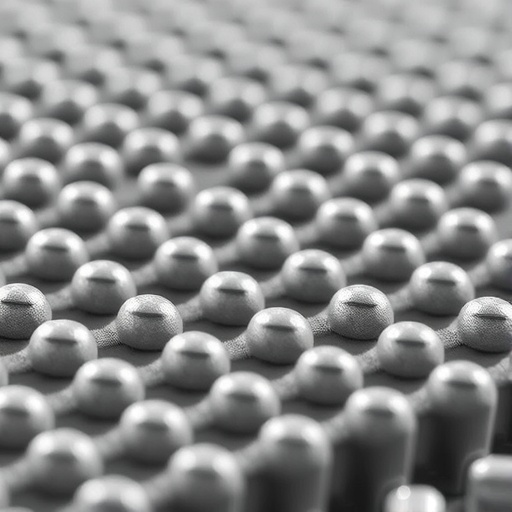Recent advances in energy storage technology are driving researchers to explore novel materials that can enhance the performance of supercapacitors and batteries. Among these materials, metal oxides have garnered significant attention due to their excellent electrochemical properties. In a compelling study, researchers have introduced a novel copper oxide and barium oxide (CuO/BaO) nanocomposite synthesized through wet chemical methods, demonstrating enhanced pseudocapacitive performance. This innovative approach not only promises to improve energy storage capabilities but also paves the way for further research into nanocomposite materials.
Pseudocapacitance, a phenomenon akin to supercapacitor behavior, relies on fast surface redox reactions to achieve high energy and power densities. It is distinct from conventional electrochemical capacitors, which rely primarily on physical charge storage. The formation of the CuO/BaO nanocomposite is pivotal, as it leverages the unique properties of both materials, leading to superior performance characteristics when utilized in energy storage applications.
The synthesis process of the CuO/BaO nanocomposite is crucial to its success. Through a series of wet-chemical techniques, the researchers were able to create a uniform distribution of CuO and BaO nanoparticles. This method allows for better control over the size and morphology of the nanostructures, significantly impacting their electrochemical performance. Such uniformity is essential for ensuring that the pseudocapacitive properties of the composite are maximized.
Once synthesized, the CuO/BaO nanocomposite was characterized using various techniques, including X-ray diffraction (XRD) and scanning electron microscopy (SEM). XRD analysis confirmed the successful formation of both cupric oxide and barium oxide phases within the nanocomposite, while SEM images provided insight into the morphology of the particles. The high surface area of the nanocomposite plays a critical role in facilitating the electrochemical reactions required for pseudocapacitance.
Following characterization, the electrochemical performance of the CuO/BaO nanocomposite was assessed through cyclic voltammetry and galvanostatic charge-discharge tests. The results revealed an impressive specific capacitance, surpassing many traditional energy storage materials. This high level of performance is attributed to the synergistic effects of the CuO and BaO components, which work together to enhance the overall charge storage capabilities of the nanocomposite.
Moreover, the stability of the CuO/BaO nanocomposite was evaluated over multiple charge-discharge cycles. Stability is a critical factor in the practical application of any energy storage material, as it directly influences the longevity and reliability of the device. The findings showed that the nanocomposite maintained its capacitance over extended cycling, indicating its potential for long-term use in energy storage applications.
The implications of these findings are profound, particularly as the global demand for efficient and sustainable energy storage solutions continues to rise. The CuO/BaO nanocomposite emerges as a promising contender in the field of supercapacitors, potentially offering not only higher energy density but also faster charging and discharging capabilities. This rapid performance is vital in applications where instantaneous energy delivery is required, such as in electric vehicles and renewable energy systems.
Furthermore, the ability to synthesize the CuO/BaO nanocomposite through wet-chemical methods is advantageous from a manufacturing standpoint. Wet chemistry often allows for lower production costs and simpler scalability compared to other synthesis methods, which is critical as the demand for energy storage technologies increases. The researchers believe that their findings could inspire further studies into similar nanocomposite systems, ultimately leading to new applications in energy storage.
Moreover, the study highlights the importance of interdisciplinary research in material science and electrochemistry. By combining elements from various fields, researchers are able to innovate and push the boundaries of what is possible with energy storage materials. Such collaborations are vital for addressing the energy challenges faced by modern society and developing sustainable solutions aligned with environmental considerations.
The emerging field of nanocomposite materials is a testament to the evolving landscape of energy storage technologies. As the demand for efficient energy solutions grows, innovations like the CuO/BaO nanocomposite will play a significant role in shaping the future of energy systems. The remarkable performance and stability of this material serve as a motivating factor for ongoing research and development in this exciting arena.
In conclusion, the groundbreaking research on the CuO/BaO nanocomposite presents an exciting development in the realm of pseudocapacitors. Through meticulous synthesis and characterization, the researchers have provided insight into the potential of this novel material. As energy storage technology continues to advance, the CuO/BaO nanocomposite stands as a beacon of innovation, showcasing the possibilities that lie in the integration of nanotechnology and materials science.
As the world moves towards cleaner energy alternatives, the findings from this research not only contribute to scientific knowledge but also inspire the next generation of engineers and researchers to pursue breakthroughs in energy storage. The journey toward more efficient, reliable, and sustainable energy systems is undoubtedly complex, but with promising materials like the CuO/BaO nanocomposite, a brighter future is within reach.
Subject of Research: Enhanced pseudocapacitive performance of CuO/BaO nanocomposite for energy storage applications.
Article Title: Enhanced pseudocapacitive performance of wet-chemically synthesized novel CuO/BaO nanocomposite.
Article References: Dhanalakshmi, B., Suresh, G., G.A., S.J. et al. Enhanced pseudocapacitive performance of wet-chemically synthesized novel CuO/BaO nanocomposite. Ionics (2025). https://doi.org/10.1007/s11581-025-06696-1
Image Credits: AI Generated
DOI: https://doi.org/10.1007/s11581-025-06696-1
Keywords: CuO/BaO nanocomposite, pseudocapacitance, energy storage, supercapacitors, wet-chemical synthesis.




